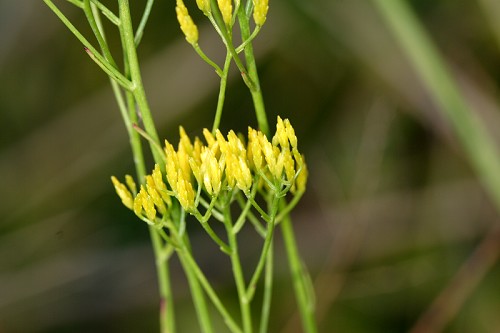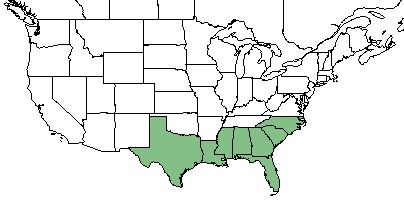Difference between revisions of "Bigelowia nudata"
(→Description) |
(→Distribution) |
||
| Line 28: | Line 28: | ||
==Distribution== | ==Distribution== | ||
| − | ''B. nudata'' is found in the Southeast United States, ranging from Texas to North Carolina | + | ''B. nudata'' is found in the Southeast United States, ranging from Texas to North Carolina<ref name= "USDA"/>; however, it is most frequent along the coast lines of lower Mississippi to North Carolina. When the species is split into the subspecies ''nudata'' and ''australis'', ''nudata'' is widespread from North Carolina to Louisiana while ''australis'' is restricted to peninsular Florida.<ref name= "Loran"/> |
==Ecology== | ==Ecology== | ||
Revision as of 13:43, 23 June 2021
Common name: Pineland Rayless Goldenrod
| Bigelowia nudata | |
|---|---|

| |
| Photo from the Southeastern Flora Plant Database | |
| Scientific classification | |
| Kingdom: | Plantae |
| Division: | Magnoliophyta - Flowering plants |
| Class: | Magnoliopsida - Dicots |
| Order: | Asterales |
| Family: | Asteraceae |
| Genus: | Bigelowia |
| Species: | B. nudata |
| Binomial name | |
| Bigelowia nudata (Michx.) | |

| |
| Natural range of Bigelowia nudata from USDA NRCS Plants Database. | |
Contents
Taxonomic Notes
Synonyms: Chondrophora nudata (Michaux) Britton
Varieties: Bigelowia nudata (Michaux) A.P. de Candolle var. australis (L.C. Anderson) Shinners, Bigelowia nudata (Michaux) A.P. de Candolle var. nudata
Description
B. nudata is a native perennial forb with fibrous roots that is a member of the Asteraceae family. The leaves are alternately arranged and oblanceolate in shape with entire margins. The flowers are yellow and give way to achene fruits (a dry fruit with a single seed).[1][2]
Distribution
B. nudata is found in the Southeast United States, ranging from Texas to North Carolina[1]; however, it is most frequent along the coast lines of lower Mississippi to North Carolina. When the species is split into the subspecies nudata and australis, nudata is widespread from North Carolina to Louisiana while australis is restricted to peninsular Florida.[3]
Ecology
Habitat
B. nudata can be found in moist sandy loams of savannahs, pine barrens, and margins of swamps as well as rich sandy soils in wet prairies and open pinelands.[3] It is a wide-ranging species, mainly occurring in wet to mesic habitats.[4][5] It can be found in disturbed sites such as front lawns and roadsides, while native habitats range from white-top pitcher plant prairies, wet pine flatwoods and cypress depressions, marsh edges, sandy scrub, dry sandy loams, and other moist areas.[6] It is considered an indicator species for the peninsular savanna community in Florida.[7]
B. nudata was found to decrease its occurrence or be unaffected in response to soil disturbance by roller chopping in South Florida. It has shown either resistance to regrowth or no change in growth in reestablished native forests that were disturbed by roller chopping.[8] It does not respond to soil disturbance by clearcutting and chopping in North Florida flatwoods forests.[9]
Associated species: Linum macrocarpum, Lophiola aurea, Sarracenia alata, Lachnocaulon digynum, Magnolia virginiana, Scleria baldwinii, and Syngonanthus flavidulus[10][11]
Bigelowia nudata is an indicator species for the Peninsula Savannas community type and is frequent and abundant in the Upper Panhandle Savannas, Lower Panhandle Savannas, and Panhandle Seepage Savannas community types as described in Carr et al. (2010).[12]
Phenology
It flowers twice a year, in the spring as well as the fall ranging from October to May.[3] B. nudata has been observed to flower in January as well as June through November with peak inflorescence in July and September.[13]
Seed bank and germination
Besides seed germination, B. nudata is known to propagate and germinate through rhizomes.[3]
Fire ecology
B. nudata seems to respond positively to fire, due to seen increase in flowering after multiple burns over time have been conducted.[14]
Conservation, cultivation, and restoration
Cultural use
Photo Gallery
References and notes
- ↑ 1.0 1.1 USDA Plants Database URL: https://plants.usda.gov/core/profile?symbol=BINU
- ↑ [[1]] Lady Bird Johnson Wildflower Center. Accessed: March 27, 2019
- ↑ 3.0 3.1 3.2 3.3 Anderson, L. C. (1970). "Studies on Bigelowia (Asteraceae, Compositae). 1. Morphology and Taxonomy." Sida 3(7): 451-465.
- ↑ Weakley, A. S. (2015). Flora of the Southern and Mid-Atlantic States. Chapel Hill, NC, University of North Carolina Herbarium.
- ↑ Anderson, L. C. (1977). "Studies on Bigelowia (Asteraceae). III. Cytotaxonomy and Biogeography." Systematic Botany 2(3): 209-218.
- ↑ Florida State University Robert K. Godfrey Herbarium database. URL: http://herbarium.bio.fsu.edu. Last accessed: June 2018. Collectors: Cecil R. Slaughter, Loran C. Anderson, Ann F. Johnson, S. W. Leonard, John B. Nelson, Bruce Hansen, JoAnn Hansen, R. K. Godfrey, L. Baltzell, R. A. Norris, R. Komarek, Lisa Keppner, Wade Biltoft, Steve L. Orzell, Edwin L. Bridges, Richard Carter, Olga Lakela, R. Kral, James D. Ray, Jr., George R. Cooley, R. J. Eaton, Sidney McDaniel, D. B. Ward, E. S. Ford, Erdman West, Paul L. Redfeam, Jr., R. R. Smith, Robert L. Lazor, M. Darst, and T. Myint. States and counties: Florida: Putnam, Walton, Franklin, Jackson, Bay, Volusia, Okaloosa, Flagler, Escambia, Santa Rosa, Wakulla, Calhoun, Liberty, Washington, Martin, Lee, Collier, Orange, Okeechobee, Osceola, Pinellas, Sumter, Pasco, Hillsborough, Sarasota, Palm Beach, Leon, Alachua, Nassau, Jefferson, and Bay. Georgia: Thomas. South Carolina: Berkeley.
- ↑ Carr, S. C., et al. (2010). "A Vegetation Classification of Fire-Dependent Pinelands of Florida." Castanea 75(2): 153-189.
- ↑ Lewis, C.E. (1970). Responses to Chopping and Rock Phosphate on South Florida Ranges. Journal of Range Management 23(4):276-282.
- ↑ Moore, W.H., B.F. Swindel, and W.S. Terry. (1982). Vegetative Response to Clearcutting and Chopping in a North Florida Flatwoods Forest. Journal of Range Management 35(2):214-218.
- ↑ Reid, C. S. and P. L. Faulkner (2010). "Louisiana." Castanea 75(1): 138-140.
- ↑ Anderson, Loran C. (1989). "Noteworthy plants from north Florida. IV." SIDA 13(4): 497-504.
- ↑ Carr, S.C., K.M. Robertson, and R.K. Peet. 2010. A vegetation classification of fire-dependent pinelands of Florida. Castanea 75:153-189.
- ↑ Nelson, G. PanFlora: Plant data for the eastern United States with emphasis on the Southeastern Coastal Plains, Florida, and the Florida Panhandle. www.gilnelson.com/PanFlora/ Accessed: 27 MAR 2019
- ↑ Hinman, S. E. and J. S. Brewer (2007). "Responses of Two Frequently-Burned Wet Pine Savannas to an Extended Period without Fire." The Journal of the Torrey Botanical Society 134(4): 512-526.